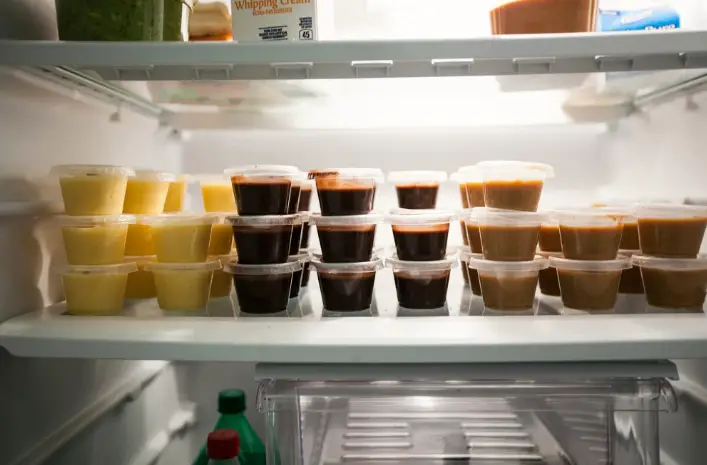How To Tell If Meatballs Are Undercooked? Is It Safe to Eat Them?

When it comes to enjoying a delicious plate of meatballs, there’s nothing worse than discovering they’re undercooked. Not only does it affect taste and texture, but it can also pose health risks. So, how do you tell if meatballs are uncooked?
In this culinary journey, we embark on a quest to demystify undercooked meatballs. How can you discern if these savory morsels are cooked to perfection? And should you even consider consuming them if they fall short? It doesn’t matter if you’re a kitchen maestro or a novice cook; understanding the telltale signs of undercooked meatballs and the potential safety concerns is paramount.
Let us therefore explore the art of the meatball, solve the riddle of doneness, and make sure that every dining experience is not only delectable but also stress-free.
Understanding Meatball Cooking
Meatball cooking is both an art and a science. It involves achieving that perfect balance between flavor, texture, and, most importantly, safety. At the heart of meatball cooking is the internal temperature. Ensuring that meatballs are cooked to the right temperature is crucial to eliminating any harmful bacteria that might be present.
Different types of meat have varying internal temperature requirements. The USDA recommends different internal temperatures for ground meats such as beef, pork, veal, and lamb. For example, ground beef should be cooked to a minimum internal temperature of 160°F (71°C), while ground poultry needs to reach 165°F (74°C).
Meat Type and Cooking Time
The type of meat you use in your meatballs plays a significant role in determining the cooking time. Thicker meatballs made from denser meats might require longer cooking times to ensure they’re fully cooked throughout. It’s essential to adjust your cooking duration based on the type of meat and the size of your meatballs.
Cooking Methods
The cooking method you choose also affects the doneness of your meatballs. Let’s take a quick look at how different cooking methods impact meatball cooking:
- Baking: Baking meatballs in the oven is a popular and convenient method. It ensures even cooking and allows excess fat to drain away, resulting in well-cooked meatballs.
- Frying: Frying meatballs can create a delicious crispy exterior, but it’s essential to monitor cooking time and temperature to avoid undercooking or overcooking.
- Simmering: Simmering meatballs in sauce can infuse them with flavor, but make sure they’re fully submerged and cooked for the recommended time.
How Do You Tell If Meatballs Are Undercooked?

How can you tell if your meatballs are undercooked just by looking at them? Determining whether meatballs are undercooked requires a keen eye and a bit of knowledge about their appearance, texture, and internal temperature. Here’s what to look for:
1. Color
Properly cooked meatballs should have a consistent brown color, both on the exterior and interior. Undercooked meatballs might appear pink or have areas that are still slightly raw-looking. This is especially noticeable in beef or pork meatballs due to their reddish hue when raw.
2. Texture
When sliced open, fully cooked meatballs should be moist but not watery, with a uniform texture throughout. Undercooked meatballs could have a slightly slimy or sticky texture, and you might notice visible pockets of pink or raw meat.
3. Internal Temperature
Using a meat thermometer is one of the most accurate ways to determine if meatballs are cooked to a safe temperature. The USDA recommends an internal temperature of 160°F (71°C) for ground beef and pork and 165°F (74°C) for ground poultry. Insert the thermometer into the center of a meatball to get an accurate reading.
4. Shape
Cooked meatballs should hold their shape well and not fall apart easily. Undercooked meatballs can be more fragile and might break apart when handled.
5. Juices
When you cut into a meatball, you should see clear juices running out. If the juices are pink or cloudy, it’s a sign that the meatball might be undercooked.
Meatball Internal Temperature
Understanding the internal temperature of meatballs is crucial for ensuring they’re safe to eat. Inserting a meat thermometer into the center of a meatball can provide an accurate reading of its internal temperature. When using a meat thermometer, follow these simple steps:
- Insert the thermometer probe into the thickest part of a meatball, avoiding contact with the pan.
- Wait for a few seconds until the thermometer gives you a reading.
- Make sure the internal temperature matches the recommended safe temperature for the type of meat you’re using.
Refer to the USDA guidelines for the specific temperature your meatballs need to reach based on the type of meat you’re using.
Table: Meat Type and Minimum Internal Temperature
| Meat Type | Minimum Internal Temperature |
| Ground Beef | 160°F (71°C) |
| Ground Pork | 160°F (71°C) |
| Ground Poultry | 165°F (74°C) |
| Ground Veal | 160°F (71°C) |
| Ground Lamb | 160°F (71°C) |
How Do I Know if Meatballs Are Cooked Without a Thermometer?
Navigating the doneness of meatballs without a thermometer is indeed possible through keen observation. Your culinary detective skills come to the forefront with these visual cues:
1. The Color Test: Grab a meatball and give it a slice. What you’re looking for is a consistent, alluring shade of brown throughout the interior. If there’s even a hint of pink or rawness, your meatball needs more time in the spotlight. The transformation from pink to brown signifies the magical moment when they’re fully cooked and ready for their grand debut.
2. Juices Speak Volumes: As you slice through the meatball, keep an eye on the juices that escape. Clear, transparent juices are your allies, indicating that the meatball has danced its way to doneness. On the contrary, if the juices still bear a pinkish hue, it’s a sign that your meatball isn’t quite ready for its close-up.
3. The Feel Test: Gently press down on the meatball with a utensil. What you’re aiming for is a palpable firmness, not a soft mushiness. This firmness is the hallmark of a well-cooked meatball, showcasing its readiness to delight your taste buds.
Is It Safe to Eat Undercooked Meatballs?
Eating undercooked meat, including meatballs, can pose risks to your health. Undercooked meat may contain harmful bacteria like Salmonella, E. coli, and Campylobacter, which can cause foodborne illnesses. These bacteria are killed when meat reaches a safe internal temperature.
If you’ve accidentally consumed an undercooked meatball, there’s a chance you could get sick. Symptoms of food poisoning from undercooked meat may include nausea, vomiting, diarrhea, stomach cramps, and fever. It’s important to note that these symptoms can appear hours or days after consumption.
Is It Safe To Eat Slightly Pink Meatballs?
It is generally safe to eat slightly pink meatballs as long as they have been cooked to an internal temperature of 160 degrees Fahrenheit. According to the USDA, color is insufficient to determine the doneness and safety of meat. The pink color inside cooked meatballs can be due to a reaction between the heat from cooking and myoglobin, a naturally occurring protein. It can also occur when the meat is cooked alongside certain vegetables.
However, if the meatballs are significantly pink or undercooked, they are not considered safe to eat. It is always recommended to use a meat thermometer to ensure that ground beef, including meatballs, reaches the proper internal temperature for safe consumption.
Steps to Take If You’ve Eaten Undercooked Meatballs
If you suspect you’ve eaten undercooked meatballs and are experiencing symptoms of food poisoning, here’s what you can do:
- Stay Hydrated: Drink plenty of fluids to stay hydrated, especially if you’re experiencing vomiting or diarrhea. Electrolyte-rich beverages like sports drinks can help replace lost nutrients.
- Rest: Give your body the rest it needs to recover. Avoid strenuous activities while you’re feeling ill.
- Seek Medical Attention: If your symptoms are severe, persistent, or worsening, seek medical attention. A doctor can provide a proper diagnosis and treatment.
- Prevent Contamination: Be vigilant about hygiene to prevent spreading any potential bacteria to others. Wash your hands thoroughly after using the bathroom and before handling food.
Preventing Undercooked Meatballs
Prevention is always better than cure, and this holds true for undercooked meatballs as well. Here are some tips to ensure your meatballs are cooked to perfection:
- Use a Meat Thermometer: As mentioned earlier, a meat thermometer is a reliable tool to gauge the internal temperature of your meatballs.
- Cooking Time: Follow the recommended cooking time for your recipe. Cooking meatballs at the proper temperature for the right duration ensures they are cooked through.
- Uniform Size: If you’re making meatballs from scratch, aim for a uniform size. This helps ensure that all meatballs cook evenly.
- Pan-Fry with Care: If you’re pan-frying meatballs, avoid overcrowding the pan. Give each meatball enough space to cook thoroughly.
- Oven-Baking: Baking meatballs in the oven on a baking sheet allows for even cooking without the need for constant flipping.
Safe Practices for Reheating Leftover Meatballs
Leftover meatballs can be just as delicious as freshly cooked ones. However, reheating them safely is crucial to avoiding any risk of undercooked portions. Follow these steps when reheating:
- Place the meatballs in an oven-safe dish.
- Add a bit of liquid, such as broth or sauce, to prevent them from drying out.
- Cover the dish with foil to help the heat distribute evenly.
- Reheat in the oven at 325°F (163°C) until the internal temperature reaches the recommended level.
In Summary
Cooking meatballs thoroughly is of the utmost importance to ensuring your meal’s safety and flavor. Raw meatballs might seem tempting, but they carry risks. Undercooked meatballs not only mar your dining experience but also open doors to potential health hazards. Therefore, a few key checkpoints come into play to determine their doneness.
Don’t let the query “Are pink meatballs undercooked?” fool you. While the association of pink with undercooked meat is valid, it’s not the only indicator. Meatball color indicators do matter; they should be uniformly brown inside. The meatball texture when cooked should be firm, not mushy. Checking the internal temperature of meatballs is your ally in this quest. Aim for a temperature of at least 160°F (71°C) to eradicate any doubts about safety.
It’s not just about appearance. How to check meatball doneness extends beyond color and texture. Pay heed to the shape and juices. Well-cooked meatballs maintain their shape and release clear juices. But here’s a crucial tip: Never rely solely on visual cues. Employ a meat thermometer for absolute certainty. Different cooking methods impact doneness; whether baking, frying, or simmering, understanding these nuances is key to a delightful, safe meatball adventure.
If your meatballs fall short of the doneness mark and you’ve taken a bite, don’t panic. Focus on prioritizing hydration and resting. If symptoms of food poisoning arise, seeking medical attention is wise. By grasping the nuances of meatball cooking, you ward off the risks of foodborne illnesses from undercooked meatballs. This knowledge lets you relish your meatballs without a hint of worry.
FAQs on How To Check Meatball Doneness or Undercooked
What should I do if I’ve already eaten undercooked meatballs?
If you suspect undercooked meatball consumption and experience symptoms like nausea, diarrhea, or fever, stay hydrated, rest, and consult a doctor if symptoms worsen or persist.
What is the best way to store leftover meatballs to prevent undercooking?
To prevent undercooking, store leftover meatballs in an airtight container in the refrigerator at 40°F (4.4°C) or below. Reheat them to the recommended internal temperature before consuming.
Can I partially cook meatballs and finish cooking later?
It’s not recommended to partially cook meatballs and then finish later, as it increases the risk of bacterial growth. Cook them thoroughly in one go.
Is pork safe to eat if it’s slightly pink in the center?
Pork should be cooked to an internal temperature of 145°F (63°C), which may result in a slight pink color. Use a thermometer to confirm the temperature.
Can I rely on cooking time alone to determine a meatball’s doneness?
Cooking time can vary due to factors like meat thickness and cooking method. To ensure safety, always use a meat thermometer to confirm the internal temperature.






